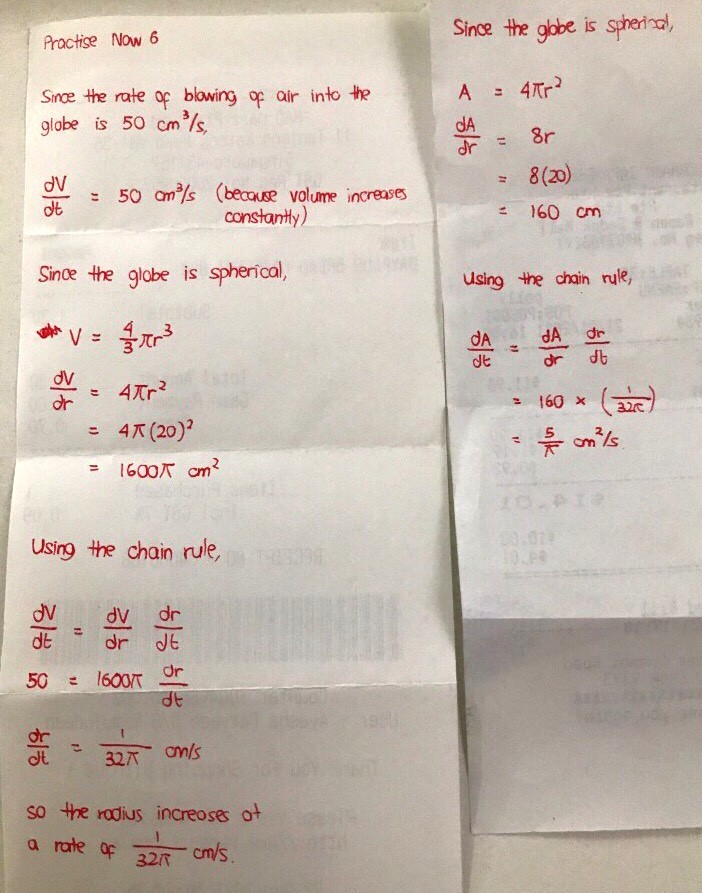Eric Nicholas K's answer to LockB's Secondary 4 A Maths Singapore question.
done
{{ upvoteCount }} Upvotes
clear
{{ downvoteCount * -1 }} Downvotes
I only have the time and strength to do this question. The remaining ones I look at a later time.
Date Posted:
3 years ago
sorry i still dont really understand this qn....
For rates of change questions, we need to formulate three expressions. Suppose A is related to B. Then we need stuffs like dA/dt, dA/dB and dB/dt and connect them together like you would for multiplication.
In this case, the quantities which are clearly linked to each other are volume and radius (because we are talking about air being blown into a sphere and the volume of a sphere is obviously a function of its radius!).
So, it becomes clear that we need to link the volume of the sphere to its radius as follows,
V = 4/3 times πr³
--------------------------------------------------------
Now, we need to find an expression for the rate of change of the radius with respect to time, which is called dr/dt. To do this, we need to obtain expressions for dV/dt and dV/dr before making the linkage.
The connection here between the three terms is dV/dt = dV/dr times dr/dt.
-------------------------------------------------------
dV/dt is already given in the question as 50 cm³/s, so what is now left is to find an expression for dV/dr when the radius r is 20 cm.
So, we need to differentiate our expression for V.
V = 4/3 times πr³
dV/dr = 4πr²
When r = 20 cm,
dV/dr = 4π (20)²
dV/dr = 1600π cm²
-------------------------------------------------------
Now, we have all that we need.
dV/dt = 50 cm³/s
dV/dr = 1600π cm²
Finally, we use the equation
dV/dt = dV/dr times dr/dt
50 = 1600π times dr/dt
And we obtain
dr/dt = 1 / (32π) cm/s
so the rate of change of r with respect to time is 1 / (32π) cm per second.
In this case, the quantities which are clearly linked to each other are volume and radius (because we are talking about air being blown into a sphere and the volume of a sphere is obviously a function of its radius!).
So, it becomes clear that we need to link the volume of the sphere to its radius as follows,
V = 4/3 times πr³
--------------------------------------------------------
Now, we need to find an expression for the rate of change of the radius with respect to time, which is called dr/dt. To do this, we need to obtain expressions for dV/dt and dV/dr before making the linkage.
The connection here between the three terms is dV/dt = dV/dr times dr/dt.
-------------------------------------------------------
dV/dt is already given in the question as 50 cm³/s, so what is now left is to find an expression for dV/dr when the radius r is 20 cm.
So, we need to differentiate our expression for V.
V = 4/3 times πr³
dV/dr = 4πr²
When r = 20 cm,
dV/dr = 4π (20)²
dV/dr = 1600π cm²
-------------------------------------------------------
Now, we have all that we need.
dV/dt = 50 cm³/s
dV/dr = 1600π cm²
Finally, we use the equation
dV/dt = dV/dr times dr/dt
50 = 1600π times dr/dt
And we obtain
dr/dt = 1 / (32π) cm/s
so the rate of change of r with respect to time is 1 / (32π) cm per second.



